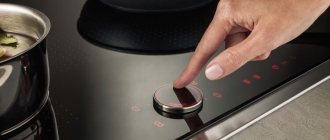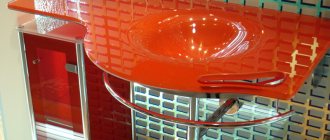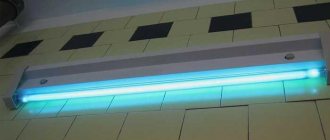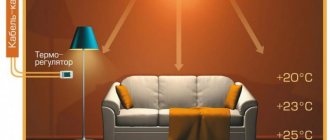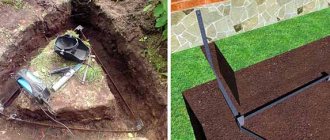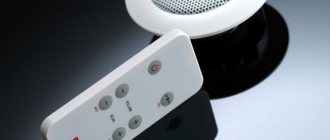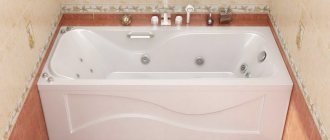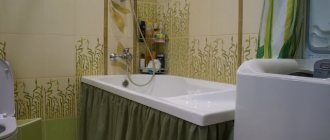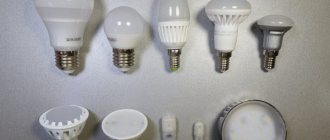Ultraviolet lamps have long been used to treat rooms in medical institutions. Later they began to be called bactericidal and used at home. Devices are often purchased by parents after the birth of a child to protect him from harmful microorganisms.
As interest in UV lamps grew, different types of devices began to appear that met the specific needs of buyers. For example, some devices used in hospitals are not suitable for use at home. You should consider the types of emitters, operating principles and purpose.
What is a UV lamp
An ultraviolet lamp is a device that emits artificial light that has bactericidal properties. The lamp emits part of the spectrum of sunlight - a neon purple glow is formed in the bulb. When the device is connected to the network, the mercury vapor inside the bulb begins to interact with electromagnetic discharges, emitting ultraviolet light.
Fig. 1 – UV irradiator.
Instead of mercury, cadmium, indium or bismuth is sometimes present inside the housing. The light emitted is in the range between X-rays and rays visible to the human eye. The UV lamp has the form of an elongated bulb, along the edges of which electrodes are installed that create a discharge to interact with mercury. Outwardly, it resembles a standard fluorescent lamp.
What is a quartz lamp used for?
A quartz UV lamp is a device based on quartz glass that transmits only ultraviolet rays. This radiation has bactericidal properties, provokes the production of vitamin D by the human body, and strengthens the immune system in winter, compensating for the deficiency of sunlight. Ultraviolet lamps for home use are used to disinfect a room, dry nails after manicure, give the skin a tan color and cope with a number of diseases.
Irradiation is divided into general and local, using attachments (tubes) that focus radiation into a given area. The instructions describe in detail what a particular attachment is for, how long you can be exposed to UV rays, and what the radiation spectrum of a particular device for home use is. Indications for the use of a therapeutic UV lamp:
- colds, ARVI, flu, inflammation of the ENT organs;
- skin diseases: eczema, psoriasis, etc.;
- joint diseases;
- prevention of rickets;
- wounds that are difficult to heal;
- ulcers, bedsores;
- gynecological indications;
- neuritis.
Household bactericidal quartz agent
An ultraviolet irradiator is needed to quartz rooms, destroying viruses and other infectious agents. A bactericidal lamp for the home is useful for families with children who are often sick. With a device for home use, you can disinfect an apartment for half an hour a day; you need to turn it on for 15 minutes, then take a break for a quarter of an hour, and re-activate the device for the same amount of time. In this mode, it works in a room of up to 20 square meters.
- What does the color of a bruise mean?
- New benefit during the pandemic
- 5 Common Causes of Dry Eyes
For tanning at home
Not all UV lamps for home use are suitable for tanning. If you try to tan under an ultraviolet device that is not intended for this, there is a risk of getting burned and accelerating skin aging. The instructions for quartz devices for special applications often contain a note that the device functions as a mini-solarium. It is not necessary to buy a quartzizer just for tanning; many therapeutic UV devices have this property. There are special installations created for tanning enthusiasts, mini-solariums.
Ultraviolet lamp for plants
An ordinary ultraviolet lamp for disinfecting premises is not suitable for illuminating seedlings or home flower gardens. When rooms are being treated with an open lamp, it is recommended to remove the plants, because excess UV rays are harmful and even fatal for them. Manufacturers produce phytolamps based on LEDs to illuminate green spaces during periods of lack of natural light.
This does not mean that ultraviolet radiation is absolutely contraindicated for plants, for example, UV rays with a wavelength of 315-380 nm stimulate the process of vitamin synthesis, radiation with wavelengths of 280-315 nm makes plants more cold-resistant, so be sure to read the instructions for your UV-C device to adjust the parameters of radiation power and wavelength. To control pests, it is useful to turn on an ultraviolet irradiator for home use for a few minutes (no more than 3-5).
Principle of operation
The operating principle of an ultraviolet lamp is almost identical to a quartz lamp. The main difference is that here, in most cases, special uviol glass is installed instead of quartz. It is necessary to filter aggressive UV radiation. Thanks to this, the device does not emit ozone, but only harmless soft ultraviolet light.
Inside the housing there are molybdenum current-carrying threads and electrodes in mercury vapor. The case is sealed and equipped with a durable base.
What effect does ultraviolet radiation have?
The ultraviolet radiation emitted by the lamp kills most known bacteria and microorganisms. The remaining part, which is not afraid of such radiation, dies from the large amount of ozone released during operation of the lamp. The problem is that ultraviolet radiation destroys not only harmful, but also useful, necessary microorganisms. The ozone released is also harmful to humans. For this reason, after using an open-type quartz lamp, it is necessary to ventilate the room. Closed-type devices (ozone-free) do not have this drawback. They are the ones that are most often used in everyday life. Let's look at what types of UV emitters exist.
Such devices are used in nail salons.
Varieties
Among existing UV emitters for disinfection, bactericidal and quartz lamps have become the most popular. In classical instruments, the flask is made of quartz glass. During operation, the device releases harmful ozone into the air.
The main difference between a UV lamp and a quartz lamp is different glasses.
Such devices are more often used for treating medical and industrial premises, where a person does not necessarily need to be present at the time of treatment. A uviol glass flask is installed in the bactericidal emitters. Structurally, ultraviolet lamps are as follows:
- portable . Due to their compactness and light weight, they are widely used in everyday life. Used to treat toilets, tables, sinks and shoes;
- open . Kill pathogenic microbes in the air and on all surfaces. There should be no animals, people or plants in the room when the device is operating. Suitable for processing large spaces;
- closed . They are called closed-type recirculators. They are often used in everyday life, since processing can be carried out in the presence of a person. The lamp design includes a fan. It is necessary to draw air inside, where disinfection with ultraviolet rays occurs. Next, the purified air goes back into the room.
Fig. 3 – closed type lamps.
In addition to design differences, ultraviolet lamps are divided by type of installation. They can be:
- floor . Best suited for disinfecting large spaces. They are often placed in a corner of the living room, hallway, bedroom or nursery. Sometimes used to disinfect wardrobes;
- mounted _ Installed on the ceiling or wall. The lamp must be mounted only on a reliable mount. Thanks to the large number of shapes and colors, the device can be selected taking into account the design of the room. The devices are characterized by increased efficiency;
- desktop _ They usually have a laconic design and small size. Such models can be used in any room, regardless of whether there are people there or not.
Fig. 4 – desktop UV irradiator.
Some models of ultraviolet color lamps are equipped with an automatic connection mechanism. If the disinfectant will be used at home, it is better to choose a portable model.
Main types of UV lamps
Practice shows that ultraviolet emitters are most often purchased for home use for disinfection purposes. Hard rays in the range of 100 to 320 nm have been proven to effectively kill microorganisms.
They destroy bacteria and mold spores, even those that are in an inactive dormant state. The radiation kills the eggs of exoparasites, dust mites, and insects.
Special ultraviolet lamps are produced designed for the normal growth of plants suffering from a lack of sunlight
It should be understood that destruction occurs only within the reach of the rays, which, unfortunately, are not able to penetrate very deeply into the wall or upholstery of upholstered furniture. To combat microorganisms, exposures of varying duration are required. It is tolerated worst of all by sticks and cocci. The most resistant to ultraviolet radiation are protozoan microorganisms, spore bacteria and fungi.
However, if you choose the irradiation time wisely, you can completely disinfect the room. This will take an average of 20 minutes. During this time, you can get rid of pathogens, mold and fungal spores, etc.
For quick and effective drying of various types of manicure gel polish, special ultraviolet lamps are used.
The operating principle of a standard UV lamp is extremely simple. It is a flask filled with mercury gas. Electrodes are attached to its ends.
When voltage is applied, an electric arc is formed between them, which evaporates the mercury, which becomes a source of powerful light energy. We provided more information on mercury-containing lamps here.
Depending on the design of the device, its main characteristics differ.
Type #1 - quartz emitting devices
The bulb for these lamps is made of quartz, which has a direct impact on the quality of their radiation. They emit rays in the “hard” UV range of 205-315 nm. For this reason, quartz devices have an effective disinfecting effect.
They cope very well with all known bacteria, viruses, other microorganisms, unicellular algae, spores of various types of mold and fungi.
Open type UV lamps can be compact. Such devices disinfect clothes, shoes and other items very well.
You need to know that UV waves with a length of less than 257 nm activate the formation of ozone, which is considered the strongest oxidizing agent. Thanks to this, during the disinfection process, ultraviolet light acts together with ozone, which makes it possible to destroy microorganisms quickly and effectively.
However, such lamps have a significant disadvantage. Their exposure is dangerous not only for pathogenic microflora, but also for all living cells. This means that during the disinfection process, animals, people and plants must be removed from the lamp's area of effect. Given the name of the device, the disinfection procedure is called quartzization.
It is used for disinfection of hospital wards, operating rooms, catering establishments, industrial premises, etc. The simultaneous use of ozonation makes it possible to prevent the development of pathogenic microflora and rotting, and to preserve the freshness of products in warehouses or stores longer. Such lamps can be used for therapeutic purposes.
Type #2 - bactericidal ultraviolet emitters
The main difference from the device described above is the material of the flask. For bactericidal lamps it is made of uviol glass. This material blocks “hard” waves well, so ozone is not formed during equipment operation. Thus, disinfection is carried out only due to the influence of safer soft radiation.
Uviol glass, from which the bulb of bactericidal lamps is made, completely blocks hard radiation. For this reason, the device is less effective
Such devices do not pose a great threat to people and animals, but the time and exposure to pathogenic microflora should be significantly increased. Such devices are recommended for use at home.
In medical institutions and similar institutions, they can function continuously. In this case, it is necessary to cover the lamps with a special casing, which will direct the glow upward.
This is necessary to protect the eyesight of visitors and workers. Germicidal lamps are absolutely safe for the respiratory system, since they do not emit ozone, but are potentially harmful to the cornea of the eye.
Prolonged exposure to it can lead to burns, which will eventually lead to deterioration of vision. For this reason, it is advisable to use special glasses to protect your eyes while operating the device.
Type #3 - amalgam type devices
Improved and therefore safer to use ultraviolet lamps. Their peculiarity is that the mercury inside the flask is not present in a liquid state, but in a bound state. It is part of the solid amalgam covering the inner surface of the lamp.
Amalgam is an alloy of indium and bismuth with the addition of mercury. During the heating process, the latter begins to evaporate and emit ultraviolet radiation.
Inside amalgam-type ultraviolet lamps there is an alloy containing mercury. Due to the fact that the substance is bound, the device is completely safe even after damage to the flask
During the operation of amalgam-type devices, the emission of ozone is excluded, which makes them safe. The bactericidal effect is very high. The design features of such lamps make them safe even in case of careless handling.
If the cold flask is broken for any reason, you can simply throw it in the nearest trash container.
If the integrity of the burning lamp is damaged, everything is a little more complicated. Mercury vapor will come out of it because the amalgam is hot. However, their number is minimal and they will not cause harm.
In comparison, if a germicidal or quartz device breaks, there is a real threat to health. Each of them contains about 3 g of liquid mercury, which can be dangerous if spilled. For this reason, entire mercury-containing lamps must be disposed of in a special way. If the light bulb is damaged, then the place where the mercury is spilled is treated by specialists.
Another advantage of amalgam appliances is their durability. Compared to analogues, their service life is at least twice as long. This is due to the fact that the flasks, coated with amalgam on the inside, do not lose their transparency. Whereas lamps with liquid mercury gradually become covered with a dense, slightly transparent coating, which significantly reduces their service life.
Ultraviolet lamp device
The ultraviolet lamp consists of the following elements:
- flask made of uviol or quartz glass;
- tungsten electrodes;
- metal base;
- molybdenum threads;
- coupling (ceramic);
- connector
Fig. 5 – design of an ultraviolet lamp.
How much does an ultraviolet lamp cost and where to buy it?
The question of where to buy an ultraviolet lamp has a clear and logical answer - pharmacies or specialized stores. If such a device is on the counter of a “1000 little things” store, be prepared for the fact that the equipment will be incomplete and the quality may be mediocre. In addition, no one can guarantee that the device will not fail after a couple of uses.
Let's look at some devices from the Solnyshko model range, their technical characteristics and cost as of January 2018:
| Model | Distance from emitter, m | Power rating, based on W/m2 | Cost, rub. |
| OUFk-320/400-03 | 0,7 | 2 | 4600 |
| 0,1 | 7 | ||
| OUFb-04 | 0,7 | 1,4 | 3500 |
| Slice, diameter 5 mm | 10,8 | ||
| Slice, diameter 15 mm | 11 | ||
| OUFv-02 | 0,5 | 2 | 3600 |
| OUFK-01 | 0,7 | 1 | 2700 |
| Slice, diameter 5 mm | 0,8 | ||
| Slice, diameter 15 mm | 1 |
The right approach to choice will make the purchase of an ultraviolet lamp for your home justified and useful.
There are even floodlights with ultraviolet light.
What is it for?
Ultraviolet lamps are used:
- for medicinal purposes. For laryngitis, sinusitis, sinusitis, non-purulent otitis media, influenza and tonsillitis. In the midst of an epidemic, ultraviolet lamps are used as a bactericidal agent. Ultraviolet radiation therapy is not recommended for children under 3 years of age. But this is possible if the newborn has a mild form of liver dysfunction (manifested as jaundice). For a runny nose and sore throat, a model with a short wavelength is suitable. Often included are attachments;
- for water purification. The devices look like a tank with a lamp. The disinfector treats the liquid with rays, destroying harmful microbes. The output is clean and usable water. It is important to learn how to determine the amount of ultraviolet light needed for cleaning. In addition, you need to change the lamp when it begins to weaken;
- for plants. When they suffer from a lack of ultraviolet radiation, the issue can be solved with the help of a phytolamp. Artificial radiation will help ensure the process of photosynthesis, which is necessary for full development.
Fig. 6 – device for water purification.
What does ultraviolet lamp kill?
Thanks to ultraviolet rays, the device is able to kill dangerous viruses, bacteria (staphylococci, bacilli, enterococci), fungi (yeast and mold) and mold.
Fig. 7 – microorganisms susceptible to radiation.
The antibacterial effect is explained by the property of short-range ultraviolet rays (up to 280 nm). They are able to penetrate the DNA of pathogenic microorganisms and destroy it from the inside, preventing further reproduction.
Also read: Differences between a recirculator and a quartz lamp.
DIY ultraviolet lamp
Those who like to equip their home with their own hands share their experience of making a mini-quartz generator for home use, which is quite suitable for disinfecting a cellar or other utility room. You will need a DRL lamp. To treat a pantry or a small room, a lamp of less than 125 W is enough. A larger cellar needs a more powerful one. Place the lamp in a bag or wrap it in a rag, put on gloves and safety glasses, and carefully break the lamp bulb with a hammer without damaging its insides.
Caution is needed as DRL contains mercury. The sealed tube remaining after removing the outer bulb is the quartz lamp. Next, you need to connect it to the inductor, or connect an incandescent lamp to it in series. You can assemble a quartz lamp on the basis of any table lamp; the one with a clothespin that allows you to direct the flow of radiation is convenient. Ultraviolet rays generated by a homemade device are dangerous for the skin and retina of the eye; a mandatory condition: use it only in the absence of people, animals, and plants.
How to use a lamp correctly at home
It is believed that ultraviolet radiation, even in minimal quantities, can be harmful to health. When using a disinfection device, you must adhere to safety precautions. Rules for using the disinfectant:
- the bactericidal device should be turned on only if there are no people in the room and only for the period of time specified in the instructions;
- If you need to treat any parts of the body with ultraviolet light, you need to make sure that the device is intended for these purposes. Before turning on, you should put on special glasses (often they are included) and close your eyes. It is also worth adhering to the recommended mode, distance to the lamp and treatment time;
- If a spectrum “C” lamp was used, it is necessary to ventilate the room after the procedure. This is necessary to remove accumulated ozone;
- When using a household recirculator, just in case, you should make sure that it is truly ozone-free. If this is not the case, you cannot turn it on in the presence of people in the room.
Fig. 8 – areas of application of recirculators.
Ultraviolet lamp for home use
General information about xenon lamps
When purchasing, say, an ultraviolet LED strip, you need to decide for what purpose it is being purchased. It’s one thing for disinfecting premises, a completely different matter for medicinal and cosmetic purposes. The range of manufactured devices is huge - from arranging a home tanning salon, treating various forms of diseases, to applying nail polish. Their prices vary widely. User reviews speak about the quality of not only foreign goods, but also domestic ones. Among them
The bactericidal devices “Dezar”, “Electronics”, “Solnyshko”, etc. are popular. The cost of such multifunctional devices with ultraviolet lamps ranges from 1,800 to 10,000 rubles. They mainly buy products for quartzing rooms, shelves, refrigerators in apartments, houses, and when health problems arise for household members. The latter, as a rule, have all kinds of attachments for treating specific areas with ultraviolet light. In any case, when using quartz lamps, including ultra-thin ultraviolet LED lamps, you must follow the rules described in the operating instructions for the device. Then safety will be ensured and the effect will be the highest.
Ultraviolet lamps have found application in various industries. They are produced to perform many tasks, without which it is impossible to obtain quality disinfection of premises and water, replenishment of ultraviolet radiation necessary for humans, treatment and other important tasks. A huge range of manufactured devices allows you to select them for specific tasks and purposes that meet specific needs.
How long can you stay under the lamp?
To disinfect the room, the device is turned on for approximately 15-30 minutes. Even if it is a harmless ultraviolet lamp, it is better to leave the room while it is working and take plants and animals with you. Upon completion of the procedure, the room must be checked. If a child has signs of acute respiratory infections, the doctor may prescribe treatment with ultraviolet rays.
Fig. 9 – Lamp for treatment “Sun”.
To do this, the child is put on special glasses, seated or placed on a couch (10 centimeters from the device) and the procedure is carried out. It lasts no more than 10 minutes. The general course of treatment is 3-4 days. After 3 sessions, cold symptoms should disappear. When treating the nasal mucosa, it can be irradiated only after the amount of discharge has decreased. Depending on the intensity of symptoms, the daily radiation dose can be reduced to 3 minutes, then to 1.
The most popular models of UV lamps
The range of ultraviolet emitters intended for home use is quite wide. Domestic manufacturers produce high-quality, efficient and quite affordable equipment. Let's consider several such devices.
No. 1 - various modifications of the Solnyshko brand
Under this brand, open-type quartz emitters of various powers are produced. Most models are designed for disinfection of surfaces and spaces whose area is no more than 15 square meters. m.
In addition, the device can be used for therapeutic irradiation of adults and children over three years of age. The device is multifunctional, therefore it is considered universal.
The ultraviolet emitter Sun is especially popular. This universal device is capable of disinfecting space and performing therapeutic procedures, for which it is equipped with a set of special attachments
The case is equipped with a special protective screen, which is used during medical procedures and is removed when disinfecting the room. Depending on the model, the equipment is equipped with a set of special attachments or tubes for various therapeutic procedures.
Since the device can be considered an open-type emitter, it is necessarily equipped with safety glasses and a biodosimeter, which helps ensure that the radiation dose is not exceeded.
Let's get acquainted with Sun UV lamps:
No. 2 - compact emitters Crystal
Another example of domestic production. It is a small mobile device. Intended exclusively for disinfection of spaces whose volume does not exceed 60 cubic meters. m.
These parameters correspond to a room of standard height with an area of no more than 20 square meters. m. The device is an open type lamp, and therefore requires proper handling.
The compact mobile UV emitter Crystal is very convenient to use. It is important to remember to remove plants, animals and people from its area of effect
While the equipment is operating, plants, animals and people must be removed from the area of its operation. Structurally, the device is very simple. There is no timer or automatic shutdown system. For this reason, the user must independently monitor the operating time of the device.
If necessary, the UV lamp can be replaced with a standard fluorescent lamp and then the equipment will work like a regular lamp.
How does the Crystal bactericidal lamp work:
No. 3 - bactericidal recirculators of the RZT and ORBB series
These are powerful closed-type devices. Designed for disinfection and air purification. The devices are equipped with a UV lamp, which is located inside a closed protective housing.
This powerful device can effectively purify indoor air without affecting the health of people nearby.
Air is sucked into the device by a fan, and after processing it is supplied outside. Thanks to this, the device can operate in the presence of people, plants or animals without being negatively affected.
Depending on the model, the devices may be additionally equipped with filters that trap particles of dirt and dust. The equipment is mainly produced in the form of stationary devices with wall mounting; there are also ceiling versions. In some cases, the device can be removed from the wall and placed on a table.
Advantages and disadvantages
Among the advantages of ultraviolet bactericidal lamps, several main ones can be distinguished:
- due to their diversity, the devices can be used in different fields of activity, as well as in everyday life;
- most models last a long time at a low price;
- devices almost instantly reach operating radiation power levels;
- modern recirculators are safe for health; they can be turned on without leaving the room.
Disadvantages include the release of ozone into the air. If you do not follow safety rules, you can harm yourself. In addition, lamps should not be simply thrown away with the rest of the trash. To do this, they are taken to specialized reception points. Also, do not forget that you need to constantly monitor the correct operation of the lamp, gradually it will begin to lose its properties.
Video: Are you sure that you have chosen the right UV lamp for your animal?
How to choose a quartz lamp for your home
To understand which UV lamp for home use is right for you, you need to understand how it will be used. If you need a bactericidal lamp for your home to disinfect the room, and it is possible to remove all household members from it for this time, including animals and favorite plants, you can plan to purchase an open lamp. Such devices kill microorganisms on all surfaces that ultraviolet radiation can reach; they are turned on to treat the room when there is a sick child or adult in the apartment (in the absence of people).
Devices that can safely operate indoors with people are open-type irradiators with a screen or recirculators. There are models whose purpose is to disinfect surfaces and confined spaces: shelves in cabinets, refrigerators, and so on. When choosing the power of equipment, it is important to know the volume of the room in which it will operate. The choice between wall-mounted, mobile or portable models depends on whether you intend to move the unit.
Attention should also be paid to the technical data of the device, the availability of a warranty, and the manufacturer’s brand. Before purchasing, read reviews of popular devices. If you buy a small device with attachments for quartzing ENT organs, you should know that if you remove all these tubes, you can quartz a small area of the apartment, no more than 3 square meters. This is enough to carry out local disinfection of the crib and bathroom, but not enough for the entire room.
- How to behave during self-isolation
- How to Combat Muscle Loss Due to Aging - Treatment and Prevention
- How to Remove Water Stains from Your Car
How much does a bactericidal irradiator cost?
Prices for home “germ fighters” start at 1,200 rubles and reach 30,000 rubles (and sometimes even exceed it). These are only quartz generators, the cost of home solariums is not taken into account. It’s easy to choose a decent device for home use at a suitable price; the range is rich; popular models are from the Russian manufacturer that produces Solnyshko quartz units. The average price of a high-quality functional ultraviolet device from this company is 2100-2900 rubles.
Another famous one. Simple open type irradiators manufactured under this brand cost 1800 rubles, a recirculator is sold for 4500-4700 rubles, there are models with a timer. Another Russian company producing bactericidal devices is Elektronika. The average cost of its UV irradiator is 3,000 rubles. Devices of the more expensive Dezar class cost about 10,000 rubles.
Life time
On average, bactericidal lamps last 8000-9000 hours. It depends on their purpose and design. The service life depends on whether the emitter overheats during operation or not.
Fig. 10 – service life of UV irradiators.
During operation, the lamp gradually wears out. This is reflected in the radiation spectrum, so over time its properties will begin to change. If deviations in the operation of the device are noticed, it is better to replace it with a new one.
Summarize
Ultraviolet emitters are useful only to those for whom they are not contraindicated - this is an axiom. You should not purchase such a device because your neighbor has one and it helps her. Before deciding to purchase, consult your doctor. Only then will the device be useful.
You need to be very careful when including homemade quartz
We hope that today's information was useful to the reader. The comments below are for your convenience. In them you can ask a question to the team of authors or share your experience in using ultraviolet emitters. We will try to answer your questions as fully and quickly as possible.
And finally, we suggest watching a short video on today’s topic:
The best professional ultraviolet lamps
Oritek OBN 150-OL
This bactericidal irradiator is suitable for disinfecting rooms with high humidity. The device can be used in kindergartens, schools, medical institutions, and at home. "OBN 150-OL" emits ultraviolet type C, wavelength is 254 nm. Such waves prevent bacteria from multiplying and lead to their death. With the help of "OBN 150-OL" you can not only clean the air of viruses and germs, but also disinfect any surfaces.
Since OBN 150-OL does not generate ozone, the lamp can be used in the presence of people. But the device should operate for no more than 15 minutes.
"OBN 150-OL" has a wall mounting type. Its power is 30 W, which is optimal for rooms with a volume of 118 cubic meters. The size of "OBN 150-OL" is 95*11.5*11.5 cm.
The average cost is 8,500 rubles.
UV lamp Oritek OBN 150-OL
Advantages:
- Destroys all types of bacteria and viruses;
- Suitable for professional and home use;
- Does not generate ozone;
- Can be used in the presence of people.
Flaws:
- Not detected.
Germicidal lamp BL-38W
Such a device is designed to combat viruses and bacteria in premises whose area does not exceed 30 sq.m. The efficiency of the device is ensured by the fact that a new model of LED lamp is installed here. This device can be used in offices, medical institutions, beauty salons and also at home.
A special feature of this device model is the presence of a timer. The device will automatically turn off after 15, 30 or 60 minutes. People and animals should not be in the room while the lamp is operating, and it is also advisable to remove plants. After finishing the operation of the device, you should ventilate the room or room for 10 minutes. Although the manufacturer has minimized the harmful effects of radiation, it is still prohibited to look at the operating device.
The size of “BL-38W” is 46*17*21 cm, and the power is 38 W. The device can be installed on a table or on the floor.
The average cost is 6,000 rubles.
Germicidal lamp BL-38W
Advantages:
- Compact size;
- Presence of a timer;
- Destroys all types of bacteria and viruses.
Flaws:
- Hard to find on sale.
Camelion LH26-FS BLB E27
"Camelion LH26-FS BLB E27" is an energy-saving lamp that has a black base. It can be used by forensic scientists to search for blood stains or verify the authenticity of paintings. This lamp will also help to detect stains after cleaning, counterfeit banknotes, impurities or verify the authenticity of precious stones. In addition, "Camelion LH26-FS BLB E27" is used to create color effects in nightclubs, when designing advertising signs or decorating shop windows.
"Camelion LH26-FS BLB E27" has a power of 26 W. The service life is 5000 hours.
The average cost is 750 rubles.
UV lamp Camelion LH26-FS BLB E27
Advantages:
- Can be used in forensics, mineralogy and agriculture;
- Long service life;
- Affordable price.
Flaws:
- Not detected.
Review of ultraviolet lamps for the home
There are many models of UV lamps on the household appliance market. Let's look at the most basic ones that occur most often.
1. Quartz ultraviolet lamp “Sun” . It is a metal case containing a quartz flask. This device is equipped with legs and can be placed on any flat horizontal surface. Using a quartz lamp, you can carry out therapeutic procedures or disinfect rooms (in this case, you need to move the lid to increase the radiation). Such ultraviolet devices are used not only at home, but also in medical institutions, schools, and kindergartens. With their help, you can cure various diseases of the skin, respiratory system, or simply strengthen the immune system. Before using at home for medicinal purposes, you should consult a doctor. Disinfection of premises using a quartz emitter should be carried out for 20 - 30 minutes in the complete absence of people. The set of ultraviolet lamp “Sun” includes:
- Plastic cone-shaped nozzles for exposing the ears, throat or nose to ultraviolet light.
- Special safety glasses.
- Biodosimeter.
- Instructions.
There are several models of such lamps. Before purchasing, be sure to study all the technical features of the devices in order to choose the one that is right for you.
bactericidal air recirculators do an excellent job of disinfecting and purifying the air . Such devices can destroy not only pathogenic microorganisms, but also foreign unpleasant odors. The recirculator is safe for people. Since the lamp is in a metal casing, and ultraviolet radiation does not lead to the formation of ozone, it can be present in the room being treated during its operation.
The operating principle of a bactericidal recirculator is based on fans sucking in air, purifying it using ultraviolet light and filters, and feeding it back into the room. Thanks to the presence of filters, the air in the recirculator is not only disinfected, but also gets rid of dust and other small contaminants.
Such devices are recommended for use in rooms where there are many people. They will be appropriate in children's institutions, fitness clubs, offices and shops, and medical institutions. Recirculators can cope with air purification even in smoking rooms and public toilets. This device weighs about 3.5 kilograms. For permanent use it can be mounted on the wall, for occasional use it can simply be placed on the floor.
3. Lamps such as “Quartz”, “Promin” and “KBB” are open-type mobile devices. They are used exclusively for treating premises for disinfection purposes in the complete absence of people. These lamps have a metal body. Depending on the model, it contains a quartz or bactericidal lamp. Before purchasing emitters of these types, carefully read the instructions and distinctive features. They have different coverage areas, some devices work with the formation of ozone, while others do not. Some lamps are intended only for use in medical facilities and public areas.
4. The Longevita UV Cure Home and Office is based on the bactericidal principle of action. This lamp is intended for use at home and in offices. The device is completely safe. Due to the bactericidal lamp, which does not transmit short-wave radiation, and the protective casing, the device can operate continuously. The emitter itself is covered with a special cover, so there is no risk of damaging your eyes. Such a household appliance works as a recirculator. In addition to treatment with ultraviolet radiation, the air is purified by a photocatalytic filter. As a result, the room is not only disinfected, but also cleared of suspended dust particles, smoke and foreign odors. This property is useful if old people or bedridden patients live in the house. The device has the following technical characteristics:
- Powered by network.
- The weight of the device is 1 kg.
- Case size - 36.5 × 14.5 × 14.5 cm.
- The area of the room to be treated is 20 square meters. m.
- The wavelength is 254 nm.
- Power - 8 W.
- Has 3 cleaning speeds.
- Installed on a flat horizontal surface.
5. The Longevita UV CURE mini is a small device that is convenient to use for small spaces such as a bathroom, kitchen or pantry. In addition, it can be used to treat the air in refrigerators, this will eliminate all unpleasant odors and significantly extend the life of the products stored in the refrigerator. The operating principle of the Longevita UV CURE mini is exposure to short-wave ultraviolet radiation with the formation of ozone. This treatment helps get rid of various bacteria, molds and viruses. Thanks to ozonation, the air becomes fresh and unpleasant odors disappear. There should be no people in the room while the device is operating. Technical characteristics of Longevita UV CURE mini :
- The device runs on 4 AA batteries.
- Case size - 12 x 6 x 4.5 cm.
- Wavelength - from 185 to 254 nm.
- The maximum area of the room to be treated is 8 square meters. m.
6. Another interesting device that emits ultraviolet light is a Wood lamp (another name is a black lamp ). It emits waves between 350 and 407 nm, which are invisible to the human eye. But thanks to this long-wave ultraviolet radiation, various organic and inorganic substances, minerals and special dyes begin to luminesce. This device does not have disinfecting properties and is not used in treatment. Wood's lamp can be used at home for various purposes.
- Using a Wood's lamp, you can diagnose some skin diseases, even without special medical education in the field of dermatology. In a dark room (preferably without windows), examine the skin with a Wood's lamp. When exposed to ultraviolet light, bacteria and fungi that cause skin problems begin to glow in different shades. If you compare the examination results with a luminescence table (it is easy to find on the Internet), you can diagnose the presence (or absence) of diseases such as lichen, lupus, candidiasis, cancer and many others.
- You can use a Wood's lamp to inspect the room to find the source of the unpleasant odor. This is especially true for cat owners who have not yet learned how to use a litter box. When exposed to ultraviolet radiation, physiological secretions and other organic contaminants will glow. To inspect, you need to turn off the lights, close the curtains and walk around the entire room, holding the device at a distance of no more than 40 cm from the surface being inspected.
- If you need to check banknotes for authenticity, you can also use a Wood's lamp. Real banknotes have special characters that begin to luminesce under the influence of ultraviolet radiation.
Which UV lamp to buy
The following are some of the most popular models of closed radiation recirculators, which can be used for sanitary treatment of large objects.
Armed SN-111-130
It has fairly compact dimensions: 10.5x11x50.5 cm. It is possible to securely mount the device on the wall.
Advantages:
- Sold complete with a convenient mobile stand.
- The body is made of metal.
- There is an indicator of the lamp performance level.
Ecoquartz 30M
It can also be hung on the wall if desired.
Advantages:
- Affordable price.
- Availability of a movable stand.
- Reliable body made of metal.
- Quite high power.
- Attractive design.
MedTeko OBR-15/2-P
The device is also mobile and can be placed anywhere. Has two light bulbs unlike the previous model. Product dimensions: 25x13.2x63 cm.
Advantages:
- Equipped with lamp hours indicator.
- There is a work timer.
- The device stops functioning if the fan is not working.
Medigez MSK-909
Another very convenient mobile unit for self-disinfection of premises. It is small in size: 63x30x13 cm and has two 15 W lamps.
Pros of use:
- Low cost and availability.
- Broken light bulbs are easy to replace yourself.
- The body is made of durable metal, so the device is as durable as possible.
Unfortunately, this specimen does not have any sensors or timers.
MedTeko OBR-30t
Another wall unit with one lamp. Has the largest overall dimensions. Its advantage is its low price, the presence of an indicator for the lamp and a shutdown function when the ventilation is not working.
Some manufacturers offer a fairly inexpensive alternative to large devices - ordinary bactericidal light bulbs that need to be screwed into the chandelier shade.
One option is the OB-03 “Photon”. The kit includes a special throttle for it. It is necessary in order to be able to screw the product into sconces with a base size of E27.
